Story and photos by Julie Reynolds
I.
“The first thing you have to learn is to call your vehicle a rig. No matter what it is, minivan, car, whatever — out here, it’s a rig.”
I was in the desert north of Quartzsite, Arizona, and it was January 2022.
I had just pulled into the federal “dispersed camping” area where a women’s caravan was gathering, and I was greeted with those words from a woman whose rig was considerably larger than mine. The sun was low on the horizon and I didn’t like the idea of setting up camp so late, but I’d gotten lost before finding the gullied dirt road to the gathering. Scattered around that vast patch of earth were dozens of old school buses, fancy Mercedes vans, huge fifth wheels, SUVs, even a Prius. All driven there by women.
This grassless prairie of pure rocks would be home for the next two weeks, when the government would require us to move along to another spot at least 20-something miles away.
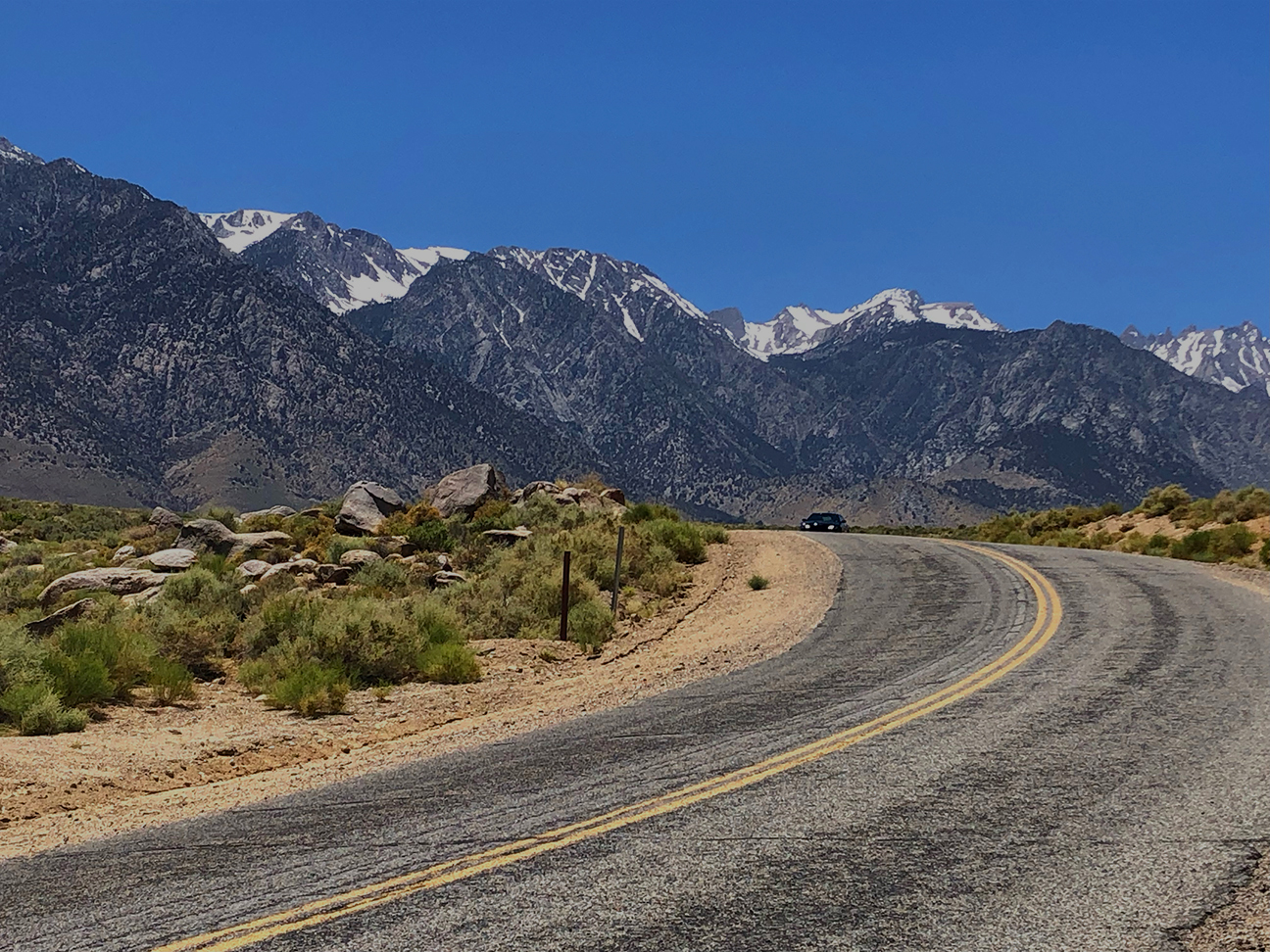
II.
“Afoot and light-hearted I take to the open road,” Walt Whitman wrote in Song of the Open Road. “Healthy, free, the world before me.”
Me? I was not afoot and absolutely not light-hearted when I took to the open road.
I have what’s called complex PTSD, and I’m in therapy for it. My travel companion is Atlas: my co-pilot, my puppy chulo, a 2-year-old chocolate Labrador retriever. He has also experienced trauma. I suppose you could say he’s a rescue dog, but in reality I am his rescue human.
Atlas and I live on California’s Central Coast, but we travel the North American West in this vehicle whose appearance I can only describe as a hippie soccer-mom van-slash-spaceship. She is the Goose, a silver-blue 2005 Town and Country minivan. Her full, formal name is Lucy, The Loose Goose.
I’m part of a band of humans who call themselves nomads, except I’m a part-time digital nomad. The “part-time” is because I still have a house — a sticks-and-bricks, as the nomads call it. “Digital” means I work remotely and therefore can earn a living anywhere I have wifi or a cell signal. Which is why I have this curved, white George-Jetson-looking satellite-thingie on top of the Goose, behind the solar panel and the big black cargo box with the Canadian, U.S. and Mexican flag stickers.
I’m not thrilled that the satellite-thingie comes from a company owned by Elon Musk, so I call it the Muskrat. But it allows me to work pretty much anywhere, and now Atlas and I and the Goose and the Muskrat — we sound like the cast of The Wind in the Willows — are all heading toward the Colorado River, where Atlas can prance like a miniature pony in the water and I can work in one of those Instagrammy settings staring out the back hatch of the Goose, sighing with a cup of tea in my hand.
And that is truly all I want to do.
Leaving with my trauma therapist’s blessing, our destination was the mother of all nomad gatherings: the Rubber Tramp Rendezvous, made famous in the book and movie “Nomadland.”
I’ve always wanted a camper van, or an RV or an Airstream trailer — all my adult life. But a year and a half ago, in the latter days of the COVID shutdown and my own full-on trauma sequelae (as my therapist calls it), I knew it couldn’t wait. So I bought a cheap used minivan and set about converting her into the Goose. I had visions of me and Atlas sitting on the back bumper in some mountain pine forest like John Steinbeck and his poodle Charley, and I was convinced that only the solitude of life on the West’s back roads could save me.
I soon discovered I was not alone in this quest.
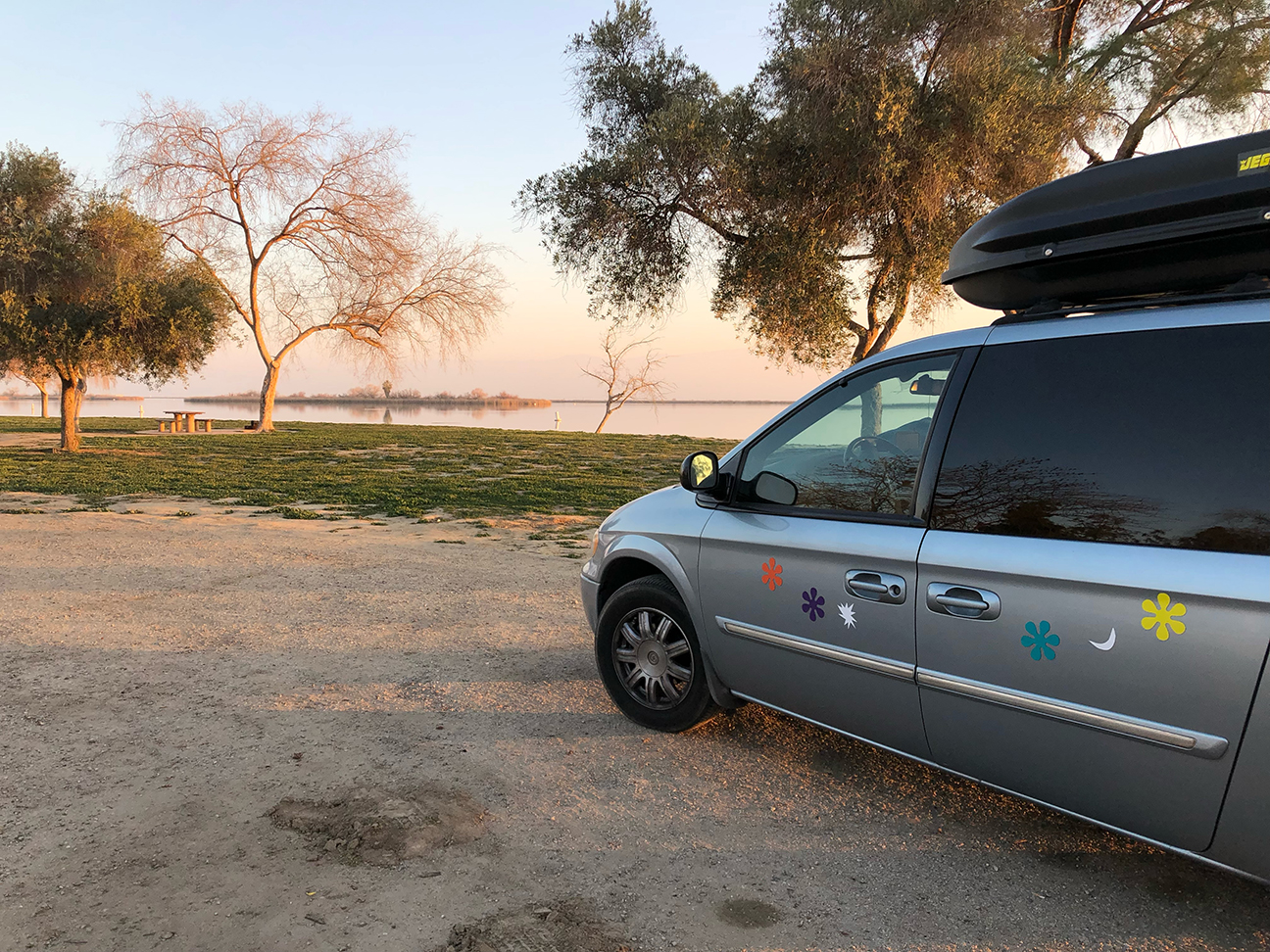
III.
Atlas was still a puppy-teenager on our first road trip of January 2022, when I simply lowered the van’s stow-and-go seats, threw a sheet of four-by-eight plywood (a.k.a. the floor), an outdoor carpet, a mattress, cooking gear and a few other essentials into the Goose and headed from California toward the rising sun: Arizona.
Though the Goose pointed east, I felt like I was headed west. To the real West: the desert, where saguaro, Joshua trees, mesquite, jackrabbits and actual cowboys live.
Leaving with my trauma therapist’s blessing, our destination was the town of Quartzsite, for the annual mother of all nomad gatherings: the Rubber Tramp Rendezvous. Nomads call it the RTR, and it was made famous in the book and movie titled “Nomadland.”
I wanted to go there because a caravan of women was camping in the desert, and that felt safer than heading into the wilderness on my own. Camping with Atlas felt safer, too, because that dog has my back. Nobody — bear, human or otherwise — is creeping up on us while he’s in the van. Even though his personality is pure Play-Doh, he can sound as vicious as a junkyard Rottweiler.
I say it felt safer rather than safe for a reason: I never feel safe.
I figured this out when trying to do one of those meditations where you imagine lying on a peaceful beach with your eyes closed. What the hell were they talking about? Okay, they said, imagine swinging in a hammock by a relaxing lake. Lying down for a nap in a mountain meadow.
Nope. No, I can’t.
I love nature, love being in nature, but my ability to be in it alone was taken from me long ago. And forget closing my eyes in real or imagined wilderness. Because of this, through most of my adult life I never walked alone in the woods. I never camped without friends or a boyfriend. Even inside a locked campervan, I would not feel safe if I were alone.
Yet as we set out on the Goose’s maiden voyage, I was hopeful that being in the desert near other caravaning women — in my steel cabin on wheels with Atlas — could give me some small piece of nature again. I wanted it back so badly I was willing to go do a thing some might describe as either courageous or reckless — camp without a male companion in the wilderness.
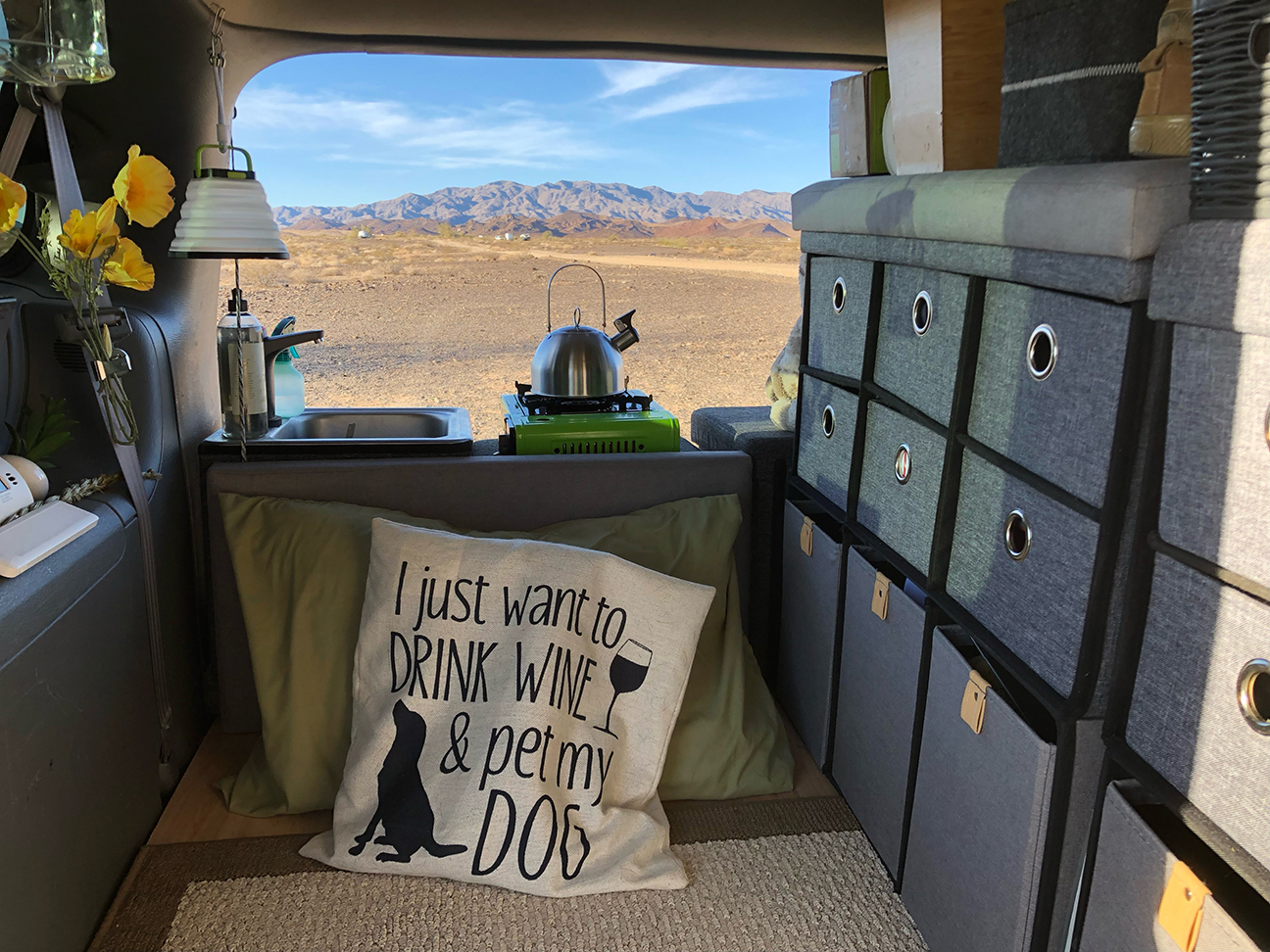
IV.
It took me a minute to understand that out here, BLM does not refer to Black Lives Matter — it’s shorthand for the Bureau of Land Management, which oversees large swaths of the West and allows free camping in much of those swaths. There are no toilets, no water, no electrical hookups or even campsites. You find a flattish spot not too close to your neighbors and you’re good. In January, when the RTR takes place, more than 200,000 people and their rigs swarm into the BLM land around Quartzsite, and the definition of “not too close” changes dramatically.
You have to be able to live fully off the grid, of course, so I had tricked out the Goose with a camping toilet that flushes, a cooler, a sink with USB-powered running water and a butane stove. I also brought a portable solar panel and a “solar power station” — a huge lithium-ion battery with built-in charge controllers and an inverter. (I didn’t know terms like that at the time, but now I throw them around like a boss.) Basically, the power station takes in solar energy and spits out AC or DC electricity. I could charge my laptop and use my phone as a wifi hotspot, which meant I could work while I was in Quartzsite.
Other than the cost of the gas to get there, I could stay somewhere scenic for free — for weeks on end. I probably spent around $350 on the whole three-week trip. I calculated that if I stayed in hotels for, say, $150 a night with all the taxes and what-not, the trip would have cost around $3,000.
Maybe Joseph Campbell would say this is universal — because what is a solitary road trip taken in desperation if not a hero’s journey?
On that first trip to join the women’s desert caravan — which was sponsored by the producers of the RTR, an admirable nonprofit called the Homes on Wheels Alliance — I met many women who traveled alone. Okay, some were accompanied by a dog or a cat or a plant, but they had no human, specifically the male of the species, along for the ride. They lived in everything from giant motorhomes to converted cargo trailers to that Prius, getting by on social security or disability or the odd job on the road. Several were working digital nomads like me. I was surprised they weren’t all gray-haired white ladies (though most were) — but there were Black, Latina and Asian women, too. Their ages ranged from their 20s to their 90s.
My very first night among them, lying in the Goose with the back hatch open and a riotous Arizona sunset and real silhouette-black saguaros, mesquite and palo verde trees as my view, I felt a tingle of hope — Instagram-worthy hope.
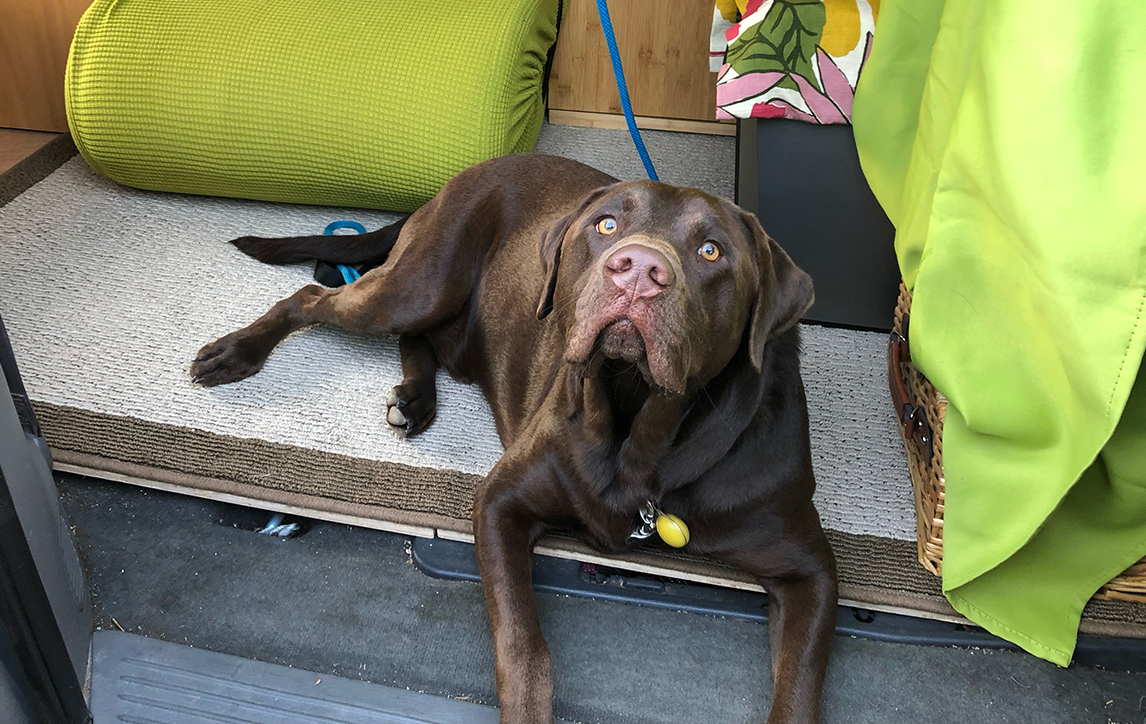
V.
Atlas is now a worldly road dog, but you might not know it on first greeting. When people meet him, they’re initially faced with a spring-coiled, atomic burst of mayhem, followed by my clumsy, apologetic and always-failed struggle to keep his 75 pounds of Labrador madness from bolting skyward and resting massive paws on someone’s shoulders. Especially if they say they just love Labs and make goo-goo “What a cute puppy!” exclamations to him.
Five to fifteen minutes later, assuming no E.R. visits are indicated, I’m able to calmly explain that he’s actually quite sophisticated, having camped in seven states, two provinces and two First Nations lands. He has made four international border crossings. No passport required, since I have no doubt the immigration agents at the Carway, Alberta, border station will not forget him after he tried to fly across my lap through the driver’s-side window into their little booth so he could prove just how thrilled he was to meet them.
That trip through Montana and into Canada was the spring of 2022, after I’d left the safety of the women’s caravan and struck out on my own. I was still afraid to boondock (as the nomads refer to dispersed, wildland camping) without a caravan, so I stayed in state and provincial park campgrounds, or the rare RV park that allowed ragtag rigs like minivans.
In an online Zoom meetup of female nomads, a woman and I realized we’d be in northern Montana on the same two days, so we agreed to camp together next to Glacier National Park.
She found a campground on Blackfeet Nation land that was only twenty bucks a night, so we set up there, built a campfire and talked until dark.
This woman grew up with her farmer parents in Kenya during the Idi Amin years, and she mentioned the violence that seeped through her childhood, hinting at trauma that shadowed her life.
It felt natural, then, for me to open up about my most recent traumatic experience, the reason I was on the road.
I told her my husband had become suddenly and unexpectedly addicted to meth and overnight had transformed into someone I didn’t recognize. How terrified I was when he was home and also when he was not at home, each situation carrying its own worst-case scenario. How he tried to hang himself twice in our bedroom. How he cursed at his puppy, Atlas, when he was three months old and kicked him down the front steps, and how Atlas and I fled our home and drove around in my Honda Civic for months, couch-and-bed surfing among the couple of friends to whom I’d bared my shameful secret. How I was sure the SWAT team that surrounded the house for the eventual arrest was going to kill him, another Brown man shot down by the cops.
There was much, much more. But one thing I’ve learned about PTSD is it isn’t a “top this” game. Your trauma may sound trivial or horrendous to someone else, and none of that matters. And while this episode in my life may seem mild compared to the suffering of so many others, it was for me the icing on a cake of decades-gone ordeals still too painful to name right now. It turns out new traumas can revive the ghosts of old ones.
Yet next to a crackling fire under this forest in the Blackfeet Nation, for the first time it felt safe to tell even this much to someone I just met. And so I did.

VI.
In my first six months of van camping, so many of the women I parked near had a story to tell, some trauma they had survived before they just picked it all up, moved into their vehicle — most of them full-time — and hit the road for the warmth of the Western sun. Domestic violence, abusive childhoods, cruel divorces, eviction, destitution, widowhood, offspring who died of suicide or overdoses, even war — many of these women had been through their own layers of hell, and they, like me, had believed they would find solace roaming the roadside West.
Most told me they did find solace, that they loved what they were doing and loved the community they’d found and forged. No one said she felt unsafe out there in the middle of freaking nowhere.
All this has made me wonder why many of us believe so fiercely that the road can heal.
How many of the road-trip books we’ve read and loved — Steinbeck’s is an exception — start with sorrow: a breakup, a death, a fight with cancer? Something that drives the writers to believe the solo road trip has the power to salve their battered hearts and souls. I’m guessing this is an American thing, since this continent is, after all, the birthplace of the automobile. Maybe Joseph Campbell would disagree and say this is universal — because what is a solitary road trip taken in desperation if not a hero’s journey?

VII.
In January 2023, a year after the Goose’s maiden voyage, Atlas was full-grown when we returned to the RTR. The Goose boasted a fancier interior. She now had bamboo cabinets, a kitchen counter, a compact fridge, plus a solar panel and the Muskrat satellite dish on top. I removed the stow-n-go seats and stashed an inflatable kayak and paddles under the floor. I’d spent the year sketching, testing and constantly remodeling the Goose’s “no-build build,” which kept my anxious, post-traumatic mind occupied.
Again in the Quartzsite desert, I met up with a fellow female sojourner from Minnesota named Brenda Zorn, who was volunteering at the RTR. How we met online is an interesting story — one for another day — but now, finally meeting in real life, we became fast friends, with lots of common interests from foraging wild foods to eating keto (she’s arguably the Keto Queen).
Atlas fell in love with her at first pounce.
One evening when I cooked a spicy peanut low-carb noodle dish, I invited Brenda to share it, and she in turn invited Graham Pruss, Ph.D., to join in. In typical nomad style, each brought their own folding chair and we sat down around my camp table.
Graham is an anthropologist who studies and advocates for modern American vehicle dwellers. When I met him, he, too, was camping in a minivan on the BLM land outside of Quartzsite. He currently lives in the Pacific Northwest, but he grew up in and later resided in Santa Clara and Santa Cruz counties. He was here in the Arizona desert to study us: the modern nomads.
I was immediately interested. I’ve since looked into the research on road travel, and it seems we nomads have discovered something science is just now figuring out: that the road heals. Researchers say driving, taking road trips and spending time alone — preferably in nature — can all help with mental focus, anxiety and overcoming trauma.
Graham has some theories about why people with trauma might take to the road.
“It can be very psychologically beneficial and helpful for people who have experienced trauma to move to a place where they’re more comfortable — to go into their van,” he later told me. “You can have that safe bubble. It’s their private comfort world that they can move through the world in.”
In addition, Graham said, the act of going forth into the world, even if protected in a steel bubble, builds an important skill for overcoming trauma: fortitude.
“What we call PTSD can also be called a response to unsafe situations that are persistently traumatizing,” he said. “We become used to those conditions, we become adaptive within those spaces because we have to.” Yet being able to take on risks in a more controlled way can be helpful at certain stages of trauma recovery.
“Riding a motorcycle, or surfing or hang gliding or van life, that tests ourselves,” Graham says, “but in a much more controlled and familiar sense. It can be a way of conquering that trauma. That is fortitude.”
It occurred to me recently that the reason I spend so much time either tinkering with, rebuilding or actually traveling in my minivan is that it is one of the very few places in my life where I feel like I have some control.
And once on the road, there is a sense of power in traversing this vastness, especially in the West’s wide deserts and vertical mountainsides. As Whitman put it more than 100 years ago, “I inhale great draughts of space; The east and the west are mine, and the north and the south are mine.”
It turns out researchers say there are brain-level reasons for this feeling.
Professor Lynne Pearce is the author of “Drivetime: Literary Excursions in Automotive Consciousness,” and is a co-director of Lancaster University’s Centre for Mobilities Research. She studies how people think while they’re driving — that contradictory combination of autopilot and rapt attention that I like to call mindless mindfulness.
“By pre-occupying one part of the brain, driving helps to calm us down and think more calmly about our problems,” Pearce says. “This is why for many of us, myself included, driving is such a great ‘time-out’ for problem solving.”
Eric Klinenberg, a professor of sociology at New York University and the author of “Going Solo: The Extraordinary Rise and Surprising Appeal of Living Alone,” says it’s the solitude that helps.
“People long for productive solitude, time to be alone in their heads to work through problems without the distraction of social media and e-mail,” Klinenberg says. “We need time and space to reflect on who we are and where we’re going in our lives, and how we can change the things we want to change.”
And what better place is there to stay offline, in total solitude, than in a moving vehicle?
“What we call PTSD can also be called a response to unsafe situations that are persistently traumatizing. We become used to those conditions, we become adaptive within those spaces because we have to.” Graham Pruss
Many of the nomad women I met have raised children and grandkids and led lives filled with people and obligations — to family, friends, neighbors, coworkers. Older now and perhaps suddenly alone, they’ve found a level of solitude once rare in their previous worlds. A few are still married, but have amicably left husbands at home to roam the country on their own. This is their time to sit with themselves, enjoying the simpler pleasure of their own company.
Perhaps being on the road alongside other modern nomads gives us the best of worlds: the ability to be alone when we want and to join others around the community campfire when we seek companionship.
Graham says friendships form fast out here, and I agree.
“It’s that shared adversity, the fact that we’ve all experienced similar traumas and have discovered ways to find new happiness in new spaces,” he says.

IX.
When I met her in Quartzsite, Brenda wore a ring she’d bought for herself. As we drank coffee inside her spacious rig, she pointed out the inscription. It read: “Did you know that I love you?”
I found myself holding back tears. Brenda knows trauma, having grown up as a “target child” — a term that refers to one child singled out among siblings to be abused by a parent. After I shared some of my story, she told me that her father, a high-ranking U.S. military officer, physically and verbally abused her throughout her childhood. The details are gut-wrenching.
“For so many years, nobody would listen,” she said. “To keep up appearances, the abuse was denied and I couldn’t talk about it. That’s the part that destroyed me. Because then I felt it was my fault.”
Today, after years of working with trauma specialists, Brenda can at last acknowledge that she is a “beautiful, gifted, intelligent and kind person” — which she is.
“And I’m finally able to live that way,” she said. She sold her house in Minnesota to live full-time in the 2008 Dodge Sprinter she’s still renovating. The van “feels like my nest,” she explained. “It’s definitely my protected spot that I can control.”
Above all, she says, nomad life is calming, especially when living and sleeping surrounded by nature.
“I don’t have to think. I can just be,” she told me. “It’s life simplified.”
X.
On the way back from Arizona to California’s Central Coast, I see an intriguing 60s-ish retro billboard for something called Bombay Beach, so I impulsively take a hard left off the highway to discover a mysterious, nearly empty ghost town that has somehow became a rogues’ gallery of insanely imaginative art, much of it created from abandoned junk, cars, even buildings.
The town feels kind of creepy, but seeing the exuberant imagination of human beings makes me smile.
Farther on, I meander along Box Canyon Road, a stunning Utah-esque drive that winds among surreal rock formations.
Box Canyon delivers me to the south entrance of Joshua Tree National Park. I know there is free BLM camping land here, but after a year on and off the road, I’ve yet to spend the night in the wild without the comfort of a small group of known caravaners surrounding me. I am still scared to do this.
Here, the familiar sight of scattered campers, huge RVs and road-worn vans along the dirt roads off Interstate 10 is unlike the RTR and the Women’s Caravans I’ve been to, because I don’t know anyone. They could all be serial killers.
After driving up and down to scope out the area, I turn back and head to Chiriaco Summit, an Interstate truck stop where I know I can park for the night next to the truckers and a well-lit, 24-hour gas station market.
But those rows of campers along the dirt roads near Joshua Tree keep calling. I’m reminded of Graham’s words: “That is fortitude. Courage and strength and the will to overcome that which makes us scared. There’s something about the nomadic community that’s particularly healing for that.”
I want to go park on the dirt, where tomorrow I can take Atlas for a walk and he can chase tiny critters — he never comes close to catching them — to his heart’s content. I want to crush this fear that keeps me from the natural world I’ve missed so much.
And so I head back to the strip of desert to park among these strangers in their cars and Class A motorhomes and everything in between.
I hunker down for the night, Atlas peacefully snoring. Me, sipping wine and enraptured by a fire-red sky behind mountains to the west — it’s the social media snapshot without the $100,000 luxury van. I’m surprised how comfortable I am, how much at home I feel parked between these roving souls I do not know.
Alone on this windswept night, I don’t feel alone. I am part of the universe around me, part of the land beneath me, and part of this precious, untethered community that has no borders. I am, as Graham puts it, in my comfort space — my bubble — in which I can move through the world.
As the darkness awakens with pinpoint stars and the I-10 freeway hums, I lie down in the Goose, the half-smile of a Buddha rising at the corners of my lips.
“I am larger, better than I thought,” Whitman writes in Song of the Open Road. “I did not know I held so much goodness.” It’s been nearly five decades coming and I know I’m still not fixed, but right here, on this night, on this patch of arid dirt, I feel safe.
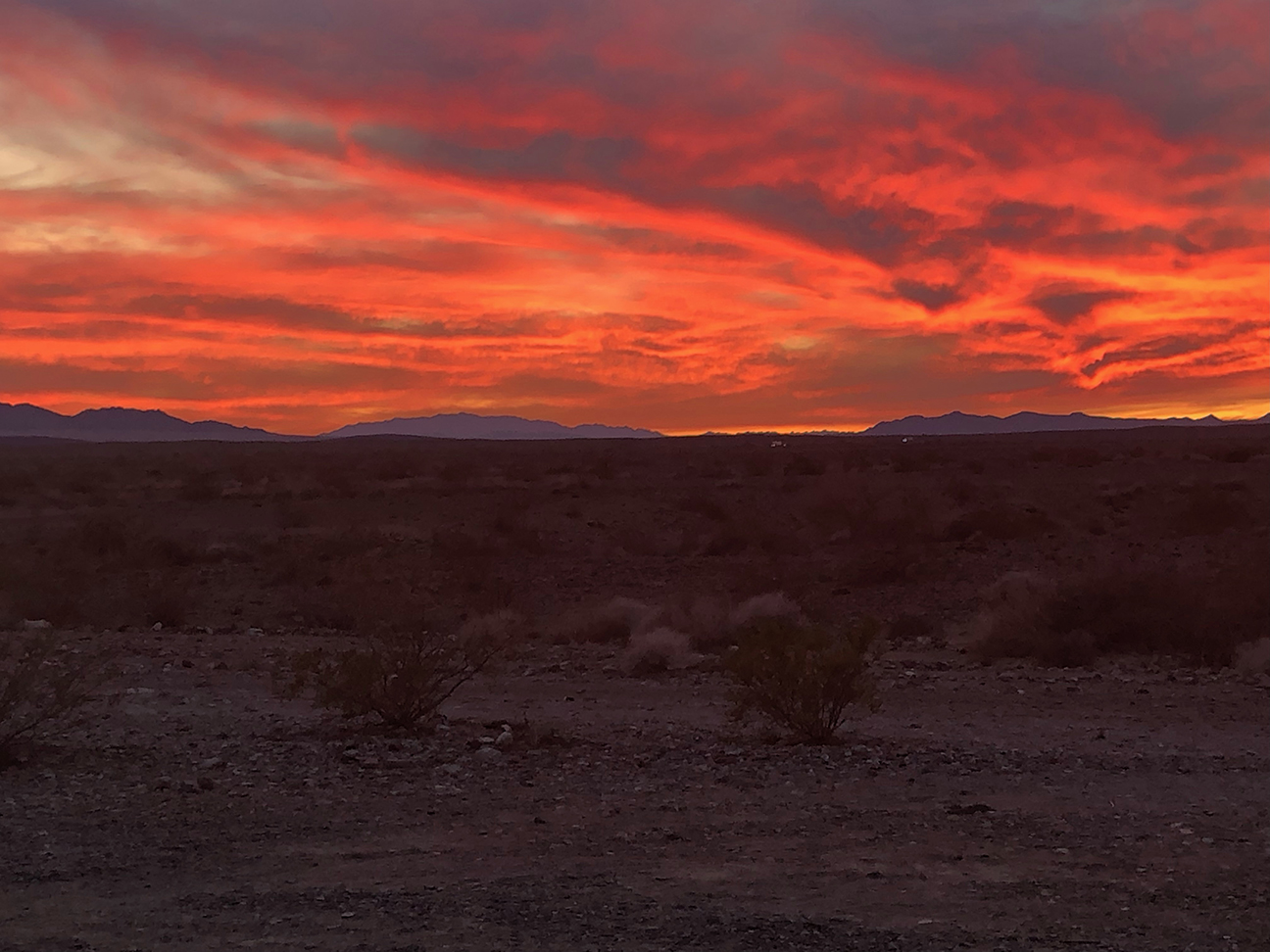
Have something to say about this story? Send us a letter.